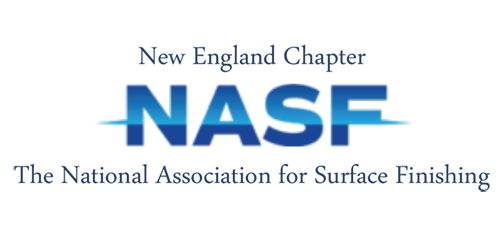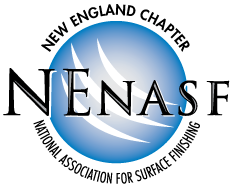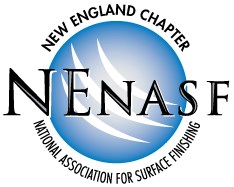NENASF SPRING SEMINAR
|
|
|
|

info@nenasf.org
508-754-2671
|
|
|
|
The New England Chapter of NASF hosted a virtual seminar for the benefit of their membership as well as the entire non-NENASF metal finishing community. The event was held on Wednesday March 8, 2023. The Executive Board opted to offer this event free of charge to all NENASF members, and at a modest fee to the rest of the metal finishing community, in hopes that it would not only educate but to bond together those associated with the metal finishing community.
In addition to offering vital technical information to the metal finishing community the event also made available two-hour Continuing Education Wastewater Treatment Contact Hours to be used towards Wastewater license renewal. It was conducted by means of Zoom format and attracted about thirty attendees. It consisted of three segments featuring five presenters over the two-hour duration from 10:00am to 12:00 pm offering a user-friendly format for all attendees.
Connor McAnespie of Hanna Instruments opened the Webinar with a presentation on the various devices available to the metal finishing/ wastewater treatment professionals to help achieve accurate results and strict compliance standards. He focused a good amount of his presentation on Automatic Titration equipment as a means for accurate reproducible results. This was followed by a presentation by Ryan Scheck of Bowman Analytical on the variety of XRF options available to the metal finishing community, and how the correct choice can not only lessen rejects but also how this equipment can be used to optimize solution maintenance and measure impurities in wastewater discharge.
The webinar was concluded with presentations by a trio from MCTA (Mass Chemistry and Technology Alliance) and OTA (Office of Technical Assistance),
an assistance branch of the Mass DEP. Katherine Robertson of MCTA opened this segment with an overview of the current regulatory status of PFAS chemicals both locally and nationally. This was followed by a presentation by Keri Sasportas from OTA explaining the emerging Environmental Justice Regulation and how it will impact the metal finishing community. The session was concluded with a presentation by John Raschko of OTA who explained the options for assistance available through that agency for the metal finishing community.
Special thanks to Chris Capalbo for moderating, and to Dev Massimi and Ralph Capalbo as Program Speaker Facilitators for their contributions, and to the combined efforts of NASF Board Members, Committee Members, Chapter Membership and dedicated and talented members of the Metal Finishing Community as a whole for making events such as this available for the benefit of our membership.
|
|
|


The New England Chapter once again was able to offer an in-person seminar for the benefit of its membership and the entire metal finishing community. Although the Chapter is still offering some virtual educational events, the Board felt strongly that there is a substantial benefit to having in-person events where the attendees can have the opportunity to network with fellow metal finishing professionals.
The event, held May 4, 2022 at the Courtyard Marriott in Marlborough, Massachusetts, was a four-hour Seminar covering mandatory annual RCRA training along with updates on hot button wastewater treatment issues, and was preceded by a luncheon.
Alisa Werst, a Senior Project Scientist at HRP Associates in Cromwell, Connecticut, was the instructor for the mandatory RCRA training portion of the Seminar. She gave a fast paced compelling and interactive presentation that was designed to provide both entry level and experienced environmental managers with a comprehensive review of state and federal hazardous waste regulations, all designed to meet the annual RCRA training requirements.
Brian Morrill, Associate Principal and Vice President at GZA GeoEnvironmental, offered a presentation on how to prepare for an environmental inspection with emphasis on how the actual inspections have been modified as a result of the COVID world in which we are living. This was followed by a presentation by Jim Occhialini, Vice President and Specialty Services Group leader at Alpha Analytical, who spoke on the rapidly evolving PFAS testing requirements the metal finishing community is being subjected to by municipalities and sewer authorities.
This seminar, and other beneficial educational events offered by the New England Chapter, are all part of this chapter’s commitment to the metal finishing community. Thank you for the combined efforts of the NENASF Board members, the Chapter Membership and the dedicated and talented members of the Metal Finishing Community as a whole who have offered their time and talents to making events like this possible.

The New England Chapter of NASF hosted a virtual seminar for the benefit of their membership as well as the entire non-NENASF metal finishing community. The event was held on Thursday March 17, 2022. The Executive Board opted to offer this event free of charge to all NENASF members, and at a modest fee to the rest of the metal finishing community, in hopes that it would not only educate but, to whatever extent possible, bond those associated with the metal finishing community.
The event was a two-hour Continuing Education Conference offering continuing education contact hours towards Wastewater license renewal. It was conducted by means of Zoom format and attracted about thirty attendees. It consisted of three presentations over the two-hour duration from 10:00 to noon offering a user-friendly format for all attendees.
Matt Kreiner of Hitachi XRF opened the Webinar with a presentation on the variety of uses and applications self-adjusting XRF units can have in saving time and money in daily coating thickness applications. He also addressed how XRF can be used to optimize solution maintenance and measure impurities in waste water discharge. This was followed by a presentation by Enrique Valentin of American Plating Power on the variety of rectifier options available to the metal finishing community, and how the correct choice can not only save money by lessening rejects, but also help reduce processing water used to reprocess defective parts.
The webinar was concluded with a presentation by Rob Sheldon of Aquas Group who spoke on the various options available through membrane technology as a substantial tool to be used in environmental regulation compliance. He also showed how this technology can be used as a path to rinse water recycling.
Special thanks to Chris Capalbo for technical support and for acting as moderator, and to Dev Massimi as Event Chair in arranging for the event speakers.
Thanks to the combined efforts of NASF Board Members, Committee Members, Chapter Membership and dedicated and talented members of the Metal Finishing Community as a whole for making events such as this available for the benefit of our membership.
The event took place this past November 12rd in Hyannis, MA. It was a huge success with over 100 people in attendance. There were speakers from all over the country that delivered educational and thoughtful presentations to all in attendance.
The New England Surface Finishing Regional is honored to have presented the 4tAnnual Foundation Award to long time supporter Roger Love of RHL Associates. The award was created to recognize a metal finishing supplier that has demonstrated outstanding contributions, support, and dedication to the annual regional event.
|

The New England Chapter of NASF was grateful to once again be able to host an in-person Seminar for the benefit of its membership and the entire metal finishing community. The event was held on Wednesday October 6, 2021. With the COVID pandemic having forced the adoption of a Virtual format for the past year and a half, the resumption of in-person meetings and the opportunity to not only learn but to network with fellow metal finishers was a welcome change and was enthusiastically received by all in attendance.
The event was once again a four-hour Continuing Education Conference offering continuing education contact hours towards Wastewater license renewal. This was especially significant being that 2021 is a WWT License renewal year for all licensed operators in Massachusetts. The Seminar consisted of four presentations over a four-hour period from 1:00 to 5:00 preceded by a luncheon for all attendees and speakers.
Matt Wright from HRP Associates opened the Seminar with a presentation entitled PFAS What Businesses Need to know stressing the importance of due diligence in preparing for regulatory enforcement of this emerging environmental hot-button issue. He stressed that saying “there is no PFAS in our plant” won’t be enough and everyone should be ready to back up statements with facts. This was followed by a presentation from Jim Walsh of MacDermid-Enthone on another hot-button issue, Sustainability. Jim gave examples of how correct equipment choices can not only lead to a company’s financial success but also to its future environmental success. David Calnan of CCI Chemicals followed with a presentation on Wastewater Treatment Options for the metal finishing industry stressing alternative treatment techniques and water recycling. The seminar closing speaker was Katherine Robertson of the Massachusetts Chemistry & Technology Alliance (MCTA) who gave an eye-opening update on the year-long Ad Hoc Toxic Use Reduction Act (TURA) Committee Hearings on reform to this burdensome Massachusetts environmental regulation and what metal finishers will be facing if certain regulatory changes become effective.
We continue to live in a very different world and it is encouraging that once again we were able to assemble for an in-person conference and networking that this event offered. We must continue to offer, through the combined efforts of NASF Board Members, Committee Members, Chapter Membership and dedicated and talented members of the Metal Finishing Community as a whole, events such as this which can be offered for the benefit of our membership.